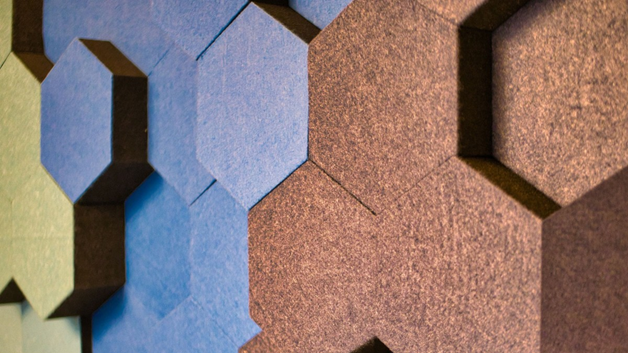BLOG 'A chronology of soundproofing systems London'
As the pandemic continues, the use of home offices is at an all-time high. Working from home can be difficult when you have an excess of outside noise distracting you. If you are working from a home office and having trouble keeping outside noise out, it may be time to soundproof your workspace. We have gathered tips from experts from Miami to Seattle to share the best ways to soundproof your home office to achieve maximum productivity.
Create a pillow cave
If you’re recording audio in your home office, try surrounding your microphone with three pillows, one on each side, and one on top. Then, lean into your newly formed pillow cave to speak. For less direct reverberation, try to face a corner in the room rather than the flat wall. Smaller spaces with sound-absorbing material, whether it’s hanging close, a blanket, or even bookshelves, helps with soundproofing. These are simple hacks won’t interfere with your aesthetic and you won’t have to spend extra money. –TechSmith
Choose your home office space wisely
Background noise can affect the way you speak or how the microphone processes your voice. When choosing a room for your video conference, avoid one that’s affected by road traffic noise, or noise from the adjoining streets or businesses. Also, avoid rooms that have noisy HVAC systems, such as AC units or ventilation fans that may be audible to others. –BKL
Use weather-stripping to reduce outside noise
One must-have in reducing outside noise during a teleconference is the installation of adhesive perimeter (i.e. weatherstripping) seals around the office door frame. For optimal success, the bottom of the door should be sealed as well. This can be achieved by installing a door bottom shoe or sweep, preferably in combination with a raised threshold. A small fan is also recommended for placement in the home office. The fan will artificially raise the background noise level and will assist in masking the audibility of household noises during a conference call. –BAP Acoustics
Opt for double pane windows
When soundproofing your home, double pane windows are a great addition to any room. Add argon gas which is 10 times denser than dead air. In extra noisy situations, having an offset glass of 3/16 and 1/8 gives it the extra boost you need. In extreme situations, laminated glass is recommended. –Golden State Windows
Convert an attic or garden shed into an office
If you haven’t yet designated your home office, then think location, location, location. Ideally, it should occupy a space that’s isolated from external sound sources, so avoid rooms that are near other homes and living spaces. Converted attics and garden studios tend to work well for this reason. In terms of remedial action, doors and windows are typically the weakest interfaces, so investing in high-quality acoustic door-sets and/or secondary glazing can make a big difference, without involving major restructuring works. –MuteSoundproofing
Apply a vibration-dampening compound
If you’re able to do even a bit of construction, you will very likely be able to reduce a significant amount of sound coming through a drywall wall or ceiling. One of the most effective and inexpensive ways to “tweak” a wall or a ceiling is to add a layer of Green Glue between the existing wall or ceiling and a new layer of drywall. The Green Glue is a vibration dampening compound that does an amazing job of sound reduction for the cost. –Acoustical Surfaces
Replace windows and doors
Most sound entering a building from the outside comes through the windows and doors. Many manufacturers perform acoustical lab tests on their window and door products to determine the Outdoor-Indoor Transmission Class (OITC) rating, which tells the consumer the product’s effectiveness in reducing traffic noise. Sound due to exterior noise can be significantly reduced by replacing existing windows and doors with assemblies with higher OITC ratings. –Noise Monitoring Services
Install automatic door bottoms
The best way to complete your home soundproof is the use of solid wood doors at least two inches thick, plus installing automatic door bottoms and jamb applied sealing systems in both interior and exterior doors. –South Bay Rustic Doors
Use mobile walls as a portable solution
Mobile walls equipped with high-performance acoustic absorbers can reduce the room’s reverberation time and lower background noise. This will give you more privacy and create a buffer from the rest of the room or house. Using a portable solution, you can move and reconfigure the mobile walls as you please. The panels can also be easily mounted to a wall whenever you need. –Absolute AV Consulting
Know the right materials to use
The most common materials used for soundproofing include:
- Acoustic Foam – This material has a distinctive wedge or pyramid shape that is highly effective at absorbing sound. They attach to walls as panels, hang from ceilings as baffles, or sit in corners as bass traps.
- Sound Insulation – sound insulation is designed to fit in between the studs of walls. The batts fit snugly between studs to take up airspace that can transmit sound.
- Acoustic Panels/Boards – These are decorative versions of sound insulation and sound-absorbing foam. They can come in many appealing colors, patterns, and fabrics to serve a dual purpose in the home and workplace. –Advanced Attic Solutions
Invest in thicker, high-quality windows
For windows, there are four factors to incorporate when trying to soundproof: size, thickness, materials & soundproof rating requirement. For size, the larger the window, the more sound can leak through. It is essential to know your options for glazing. You can laminate, use an insulated glass unit & incorporate varying thicknesses of glass. The air space between panes also affects the STC; larger air space between panes will have a higher STC. Different glass thickness will block out different sound wavelengths. –Port Window Glass
Attempt to achieve complete sound isolation
Soundproofing a room, actually called sound isolation, really depends on how much sound you’re trying to deaden. Specific construction products and methods are required for complete sound isolation. Some simple tricks to reduce sound include insulating interior walls, replacing hollow doors with solid doors, and covering any potential air gaps in the wall. -Dave Pedigo, CEO, Auralex Acoustics
Fill your walls with cellulose or mineral wool
When soundproofing, I would be cautious to use anything that has a moisture barrier despite what some people say. Make sure to check that there isn’t a fire block. You may have to drill a second set of holes halfway down using a 15/16 sized bit which makes a hole about the size of a quarter, easy to plug, and hide with some mudding and paint. Use a cellulose product because it’s ground-up smaller and you can pack more in. -Rick McKinney, owner of McKinney Insulation.
There are two options for installing soundproofing in pre-existing structures. The first is to fill the existing wall with cellulose through 1-inch holes drilled every sixteen inches to create an airtight seal after which you patch the holes and paint over. The second method is to remove the inner wall, install mineral wool the entire length of the wall, and install new drywall to replace the removed material. –Attic Elite
Soundproof Your Door
To soundproof the door of your home office, the most effective product is a Sound Transmission Class rated door. If you don’t want to break the bank, as these doors can get expensive, a simple solid core 1-3/4’’ thick flush door will also yield great results. Most people don’t know that the majority of sound travels through the gaps between the door, frame, and floor, so make sure you use gasketing and a door sweep to minimize air space, and therefore sound transmission. –Manhattan Door
Originally Published on Redfin

 +44 (0) 20 3858 0833
+44 (0) 20 3858 0833 email
email






















